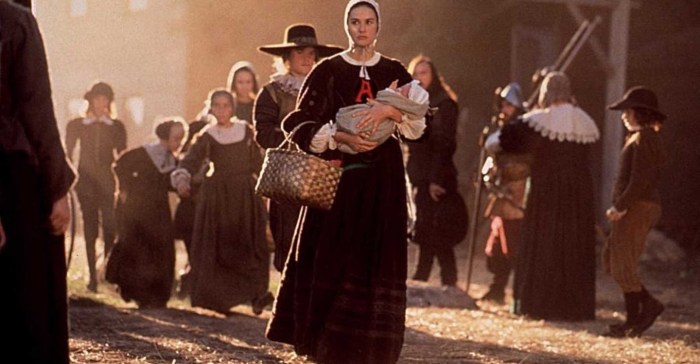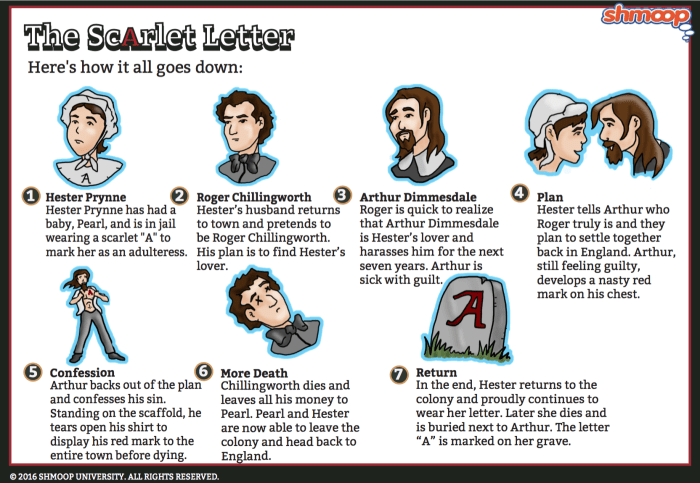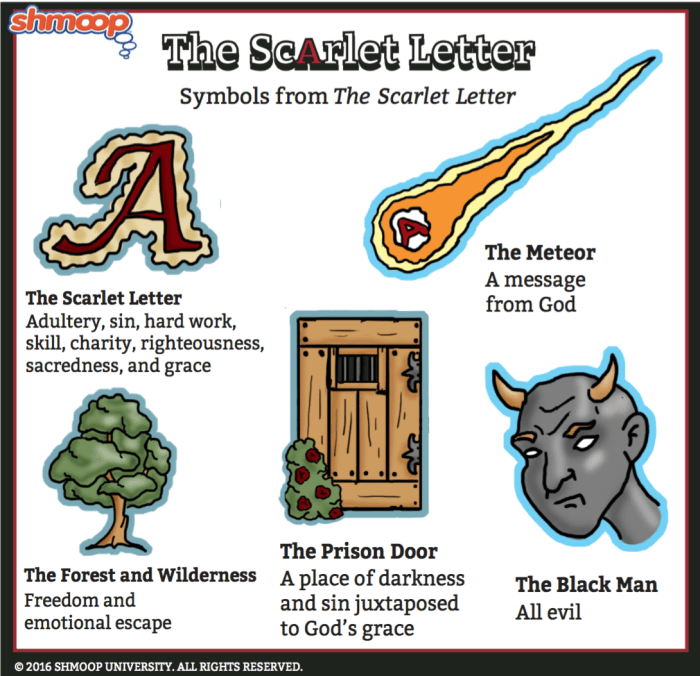Scarlet letter ch 5 summary – In the realm of literature, Nathaniel Hawthorne’s “The Scarlet Letter” stands as a masterpiece, and Chapter 5 unveils a pivotal moment in its narrative. This chapter summary delves into the heart of Hester Prynne’s punishment, introduces the enigmatic Black Man, and explores the profound encounter in the forest.
Join us as we unravel the secrets and symbolism that shape this captivating chapter.
Introduction

In Chapter 5 of Nathaniel Hawthorne’s “The Scarlet Letter,” we delve deeper into the evolving relationship between Hester Prynne and her lover, the Reverend Arthur Dimmesdale. This chapter sets the stage for a pivotal encounter between the two characters, which will have profound implications for both their lives.
As the chapter opens, Hester has emerged from the forest, her scarlet letter a beacon of shame and isolation. She approaches the scaffold, the site of her public humiliation, where she encounters Dimmesdale. Despite their previous encounters, this meeting is charged with a sense of urgency and desperation.
Hester is determined to confront Dimmesdale about his role in her downfall and the hidden sin that has tormented him.
Hester Prynne’s Punishment: Scarlet Letter Ch 5 Summary

Hester Prynne’s punishment for adultery is a scarlet letter “A” that she is forced to wear on her chest. This letter serves as a constant reminder of her sin and isolates her from the community. The punishment is designed to humiliate and shame Hester, and it has a profound impact on her life and identity.
Impact on Hester’s Life
The scarlet letter affects every aspect of Hester’s life. She is shunned by society and treated as an outcast. She is unable to find work or a place to live, and she is constantly harassed and ridiculed by the townspeople.
The letter becomes a burden that she cannot escape, and it weighs heavily on her mind and soul.
Impact on Hester’s Identity
The scarlet letter also has a significant impact on Hester’s identity. She is no longer seen as an individual, but simply as a sinner. The letter defines her in the eyes of the community, and it becomes a symbol of her shame and disgrace.
Hester struggles to come to terms with her new identity, and she eventually becomes a different person than she was before.
The Black Man

The enigmatic figure known as the Black Man makes his first appearance in Chapter 5 of “The Scarlet Letter.” His presence adds an air of mystery and intrigue to the narrative, hinting at the complex web of sin and redemption that lies at the heart of the novel.
The Black Man is described as a tall, imposing figure with a “dark and sable countenance.” He wears a suit of black clothes and a broad-brimmed hat that casts a shadow over his face. His eyes are “deep and inscrutable,” and his demeanor exudes an aura of authority and power.
Motives and Actions
The Black Man’s motives and actions remain largely shrouded in mystery throughout the chapter. He appears to have a keen interest in Hester Prynne and her daughter, Pearl, and he seems to possess a deep understanding of their circumstances.
He approaches Hester in the forest and engages her in a conversation that explores the nature of her sin and the consequences she faces. He questions her about her relationship with Dimmesdale and suggests that she should seek forgiveness and redemption.
However, his words also hint at a more sinister agenda, as he warns Hester that her secret will eventually be revealed and that she will face severe punishment.
The Black Man’s actions and motivations remain ambiguous, leaving the reader to speculate on his true nature and purpose. Some scholars interpret him as a symbol of evil or temptation, while others view him as a more complex figure who represents the hidden aspects of Hester’s own psyche.
The Meeting in the Forest

In the secluded forest, an encounter unfolds between Hester, Dimmesdale, and the enigmatic Black Man. The forest becomes a sanctuary, a place of both revelation and temptation.
The Dynamics Between the Characters
Hester and Dimmesdale, both outcasts, find solace in each other’s presence. Their shared secret and mutual affection create a bond that transcends their societal condemnation. The Black Man, a shadowy figure, represents temptation and the allure of darkness. His presence tests their resolve and threatens to expose their forbidden love.
The Significance of Their Conversation
Their conversation delves into the nature of sin, redemption, and the hypocrisy of society. Dimmesdale, torn between his religious vows and his love for Hester, grapples with his guilt. Hester, strong and defiant, challenges societal norms and seeks a path to redemption on her own terms.
The Black Man offers a seductive alternative, promising freedom and power, but at a great cost.
Symbolism and Imagery

Chapter 5 of The Scarlet Letter is replete with symbolism and imagery that contribute to the novel’s themes and atmosphere. Hawthorne uses these literary devices to convey complex ideas and emotions in a vivid and memorable way.
Nature and Symbolism, Scarlet letter ch 5 summary
Nature plays a significant role in Chapter 5, serving as a backdrop for the characters’ interactions and as a symbol of their inner states. The forest, for instance, represents the untamed and mysterious aspects of human nature. It is a place where secrets are hidden and where the characters can escape from the judgmental gaze of society.
In Chapter 5 of The Scarlet Letter, Hester Prynne’s strength and resilience are put to the test as she faces public scrutiny. This theme of perseverance is also explored in the Mier y Teran report , a historical account of the Mexican-American War, where the soldiers’ unwavering determination is highlighted.
Returning to The Scarlet Letter, Chapter 5 concludes with Hester’s unwavering spirit, setting the stage for her journey of redemption.
The scarlet letter itself is a potent symbol of Hester’s sin and the shame she must bear. It is a mark that sets her apart from the rest of the community and isolates her from human connection. The letter becomes a constant reminder of her past and the consequences of her actions.
Color and Light
Hawthorne also uses color and light to create a specific atmosphere in Chapter 5. The darkness of the forest contrasts with the bright sunlight of the meadow, representing the characters’ conflicting emotions and the struggle between good and evil.
The black man’s clothing and the red glow of his eyes symbolize his sinister nature and the evil that he represents. In contrast, the white light of the minister’s sermon represents hope and redemption.
Foreshadowing
Chapter 5 of The Scarlet Letter foreshadows several significant events and themes that will unfold throughout the novel. These clues and hints provide readers with insights into the novel’s ultimate outcome and the complex relationships between the characters.
One of the most striking examples of foreshadowing in Chapter 5 is the appearance of the Black Man. This mysterious figure, who is described as having “a visage as black as midnight,” is associated with both evil and temptation. His presence in the forest where Hester and Dimmesdale meet suggests that their secret affair will have dire consequences.
Another instance of foreshadowing occurs when Hester and Dimmesdale discuss the possibility of running away together. Dimmesdale’s hesitation and reluctance foreshadow the difficulties they will face in maintaining their relationship in the face of societal disapproval. His inability to fully commit to Hester hints at the tragic end that awaits them.
The chapter also foreshadows the novel’s exploration of sin and redemption. Hester’s decision to wear the scarlet letter as a badge of her shame foreshadows her eventual path towards redemption. Dimmesdale’s internal struggle with his own guilt foreshadows the psychological torment that will consume him as he keeps his secret hidden.
Quick FAQs
What is the significance of Hester Prynne’s punishment?
Hester’s punishment of wearing the scarlet letter “A” serves as a constant reminder of her sin, isolating her from society and subjecting her to public humiliation.
Who is the Black Man, and what role does he play?
The Black Man is a mysterious figure who appears to Hester, Dimmesdale, and Chillingworth at different points in the chapter. His presence represents temptation, evil, and the consequences of sin.
What is the importance of the meeting in the forest?
The meeting in the forest is a pivotal moment where Hester, Dimmesdale, and the Black Man confront their past and present sins. It reveals the complexities of their relationships and the hidden desires that drive their actions.